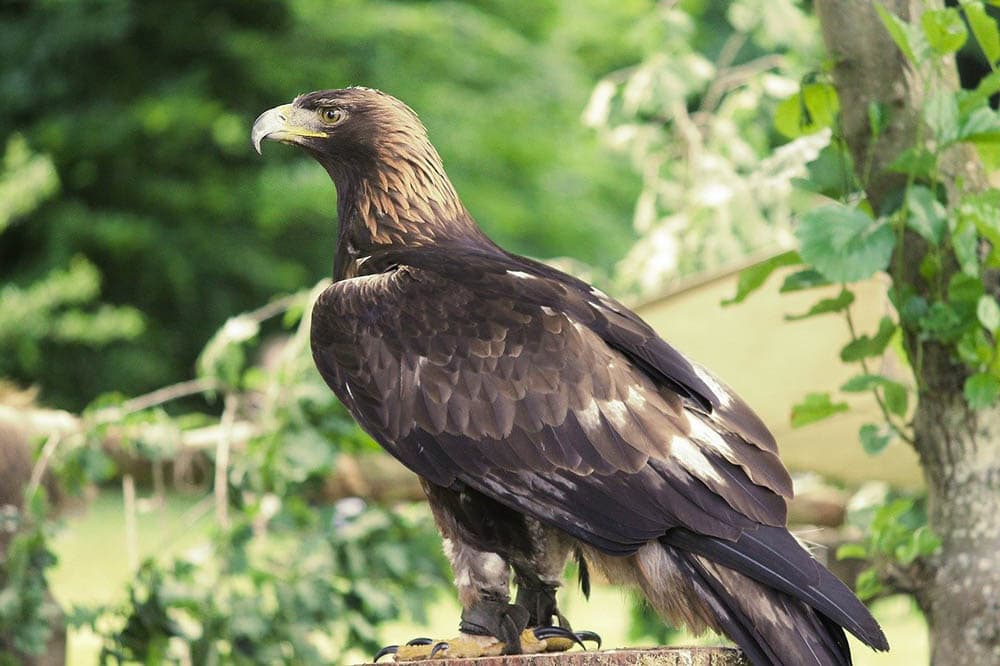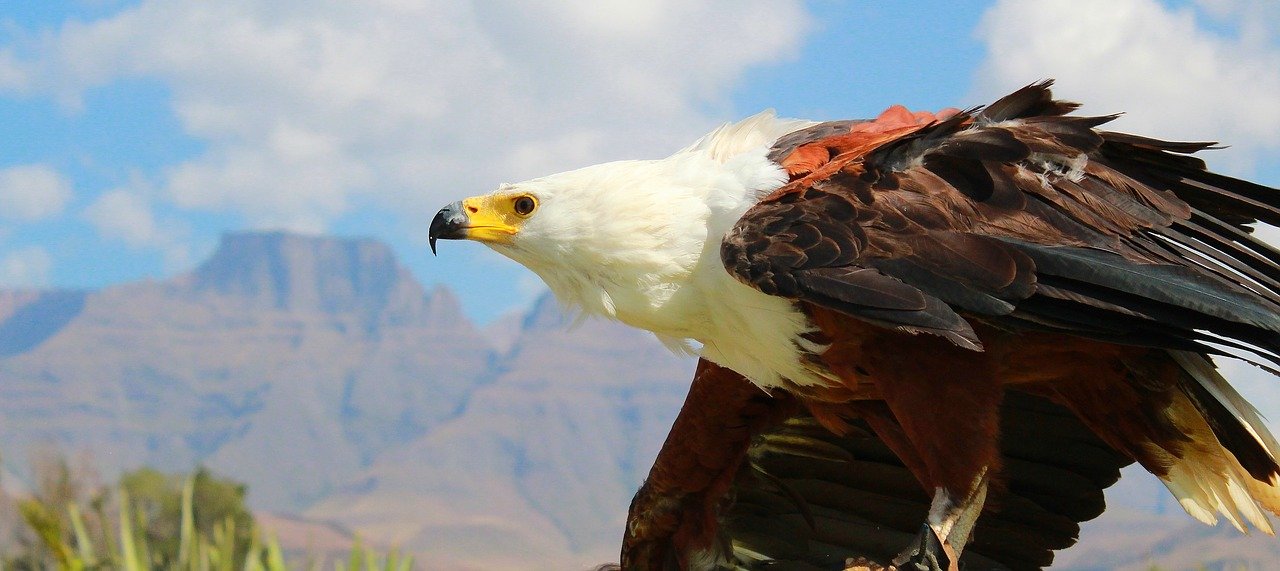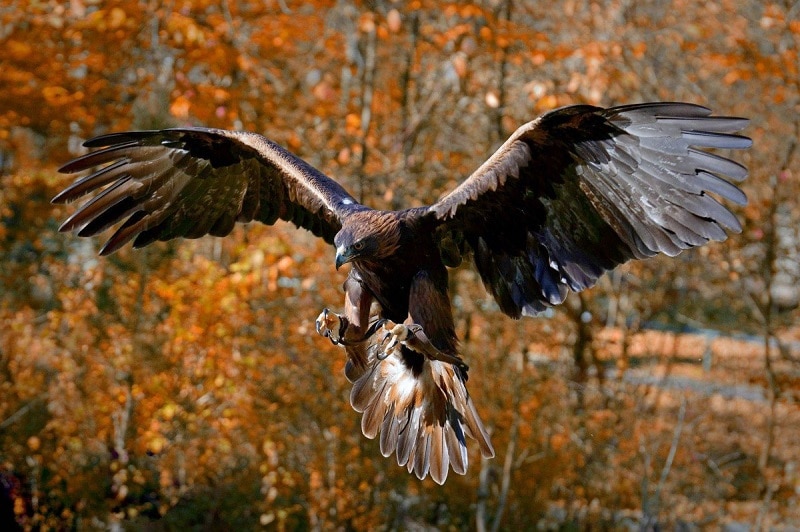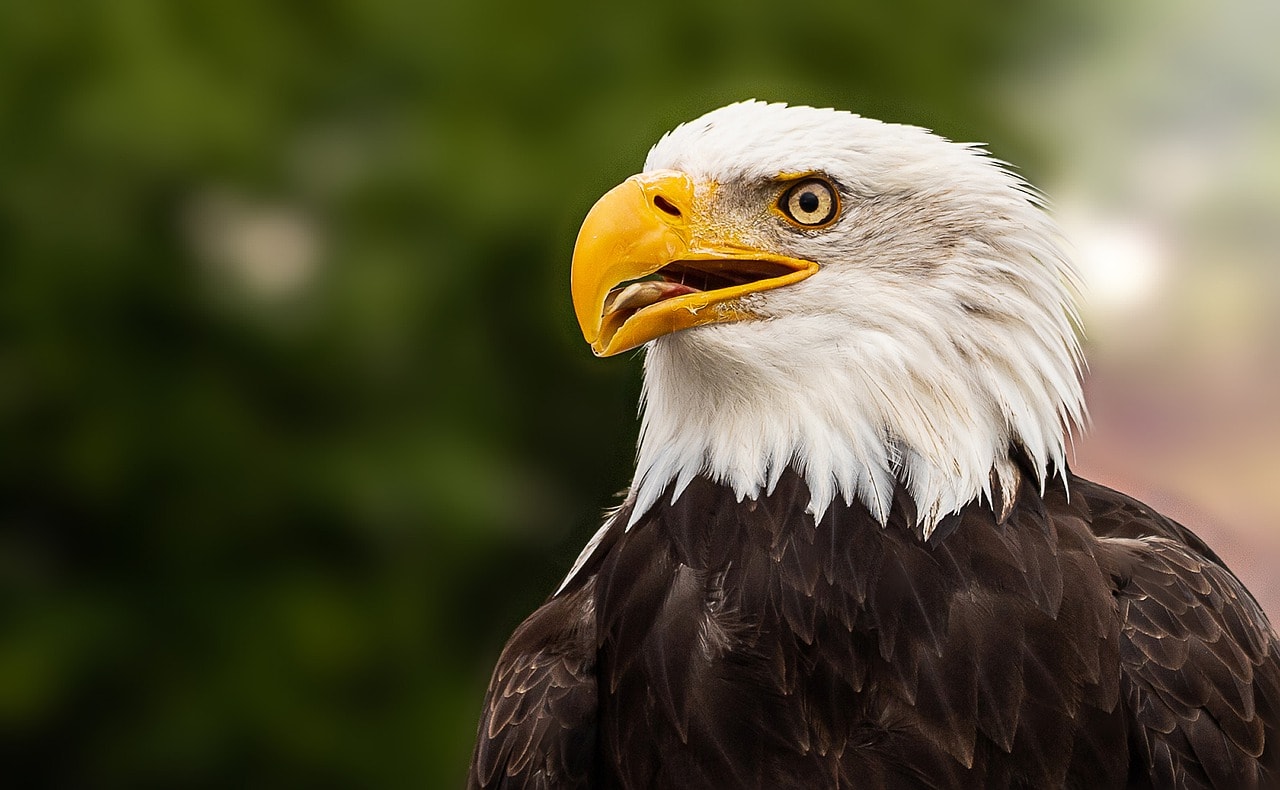24 Fascinating & Fun Eagle Facts You Never Knew
Last Updated on

We’ve always believed that studying birds is important, as it helps us understand the different ecosystems that support various life forms on earth. And of course, some of you might disagree with this, but in our view, the only way that we’ll be able to live on a healthy and sustainable planet is if we fully comprehend how the elements in our natural systems function.
Keeping that in mind, today’s piece won’t just be about birds in general, but about the eagle. So look for a pen and paper, and jot down the following facts!

The 24 Most Interesting Facts About Eagles
1. The Fish Eagle is a status symbol.
The Fish Eagle is one of the most common eagles in Africa, and it’s a national bird in three countries: Southern Sudan, Zambia, and Zimbabwe.
In Europe, several countries use it on their coat of arms, including Germany, Mexico, Austria, and Poland.

2. Eagles are resilient.
Take an example of a situation where the bird just caught its prey in the water, but the prey is too heavy for it to carry it all the way to its feeding ground. Now, instead of letting the prey go, it will crash land on water, and start swimming.
And because it knows wetting both wings will leave it defenseless should a predator show up, it will only use one wing.
3. Communities have different names for the eagle.
When you visit communities in France, you’ll hear them call it the aigle pêcheur. In Africa, it’s called the hungwe by the Shona community, the inkwazi by the isiZulu, and visarend in Afrikaans.
4. They are naturally territorial.
All eagle species are territorial in nature. And that’s obviously the reason why on more than one occasion, they’ve been seen engaging in turf wars within their species. The only time that you will see an eagle tolerate another eagle, is when they have all realized that the food and water supply is scarce.
5. The rarest eagle is the Great Philippine Eagle.
In fact, it’s not just the rarest eagle, but the largest as well. That’s only if we’re talking about its length and wing surface, and not the weight.
Sadly though, it’s facing extinction, as we only have less than 1,000 of them remaining. Some of the causes listed for this rapid population decline include habitat loss, human interference, climate change, and viral diseases.

6. The Great Philippine Eagle is sometimes referred to as the Monkey-Eating eagle.
So, this species was discovered in Samar, Bonga, which is a place in the Philippines. It was during that period that the people living around that area constantly talked about a large bird that kept on feeding on monkeys. We still don’t know if those rumors were true or not, but that’s how the name came about.
7. Steller’s Sea Eagles are the heaviest.
The female Steller’s Sea Eagle will weigh anything from 13.7 to 20.9 pounds, while the male will be slightly lighter. This bird of prey is just as vicious as all the other eagle species and is considered diurnal.
Unfortunately, just like the Great Philippine Eagle, they are fighting for survival. Overfishing, industrial pollution, and habitat alteration are all items listed as causes for their dwindling population.
8. Eagles mate for life.
The only time that you’ll see an eagle seek a different mate is when one of them has passed on or gone MIA. But that rarely happens, and you’ll see them use the same structure year in year out, whenever they feel ready to mate again.
You’ll also realize that the nest keeps growing bigger the longer they stay together. It’s because they often add more materials to the structure at the beginning of every mating season.
9. The baby of an eagle can be called a nesting or eaglet.
The babies of an eagle are cute, but very stubborn. And when they are learning how to fly, they’ll always take too long to perfect the art. The landing bit is mostly the hard part, but once they get the hang on it, they look like naturals.
A juvenile eagle won’t leave its nest immediately after it learns how to fly on their own. It will stick around for five, six weeks, before flying to a different location. This phase is called the fledgling phase.

10. Females only lay eggs during spring.
Every year, the female will search for a good nesting ground, and start laying eggs. If they’ve ever laid eggs before, they’ll go back to the same nest. Typically, they usually lay one to three eggs, and the incubation period is 39 to 45 days. The male will be responsible for bringing food and offering protection.
11. A group of eagles is referred to as convocation.
Convocation is a collective noun used to refer to a group of eagles. It’s just the same as “gaggle,” which is used to refer to a group of geese, or “murder,” used on a group of crows.
Convocation is believed to have been derived from the Latin word ‘aquila.’ But we’re not so sure how or why it’s related to eagles, even though some researchers think it’s because it’s the derivative of the word ‘aquilus’ which means dark-colored — Possibly referring to the dark plumage of eagles.
12. Eagles have one of the most powerful grips in the bird kingdom.
It is estimated that the strength of a grip of a typical eagle is ten times that of an average human hand. An adult human will only be able to exert a pressure of 40 pounds per square inch (psi), but that of an eagle can reach and even surpass 400 psi.
The eagle gets its power from its bones, tendons, and leg muscles. It’s actually like a reflex of some sorts, because anytime it spots a prey the tendons automatically tense up, and then contract once it gets into contact with its intended target.
That contraction is what causes the leg muscles to close the bird’s talons, thus capturing its prey.
Anytime the tendons contract, their ridges — together with those found on the sheath —interlock right away. This effect creates another effect known as “ratchet effect,” which ensures the bird doesn’t struggle to keep its talons closed for a long period of time. Subsequently, subduing even an oversized prey.

13. You’ll most likely find an Eagle’s nest on top of a cliff.
The eagle will take into consideration a couple of factors before building a nest. First off, the nesting ground has to be a suitable one. By that we mean, it has to provide shelter against adverse weather conditions, and be higher than all the surrounding vegetation. This is to ensure the bird doesn’t get caught off guard by any predator/intruder, or struggle to gain access.
Those that prefer living in habitats not defined by high cliffs will settle for super tall and strong trees. The kind that have stopped growing and are nearing the end of their life cycle.
14. Eagles have eyes almost the same size as the human eye.
And because they have small heads relative to humans, it’s safe to say their eyes fill up most of the space inside those skulls.
Their eyeballs are usually stationary, courtesy of a ring called the sclerotic ring, which holds them in place.
15. An eagle’s eyes are so powerful.
These birds of prey are favored in the eye department, since they have the option of choosing between monocular vision, and binocular. To put that in a different way, they can decide to either use their eyes independently, or simultaneously.
That eye has two foveae — fovea is a tiny pit, usually found in the retina’s macula. It’s the point at which the retina’s layers spread aside, so as to allow light to access the cones. Cones, on the other hand, as the cells that bring into focus the different images created, thereby giving them a sharper look.
Having two foveae means it’s possible for the bird to view objects straight ahead, and those positioned to the side, at the same time. You should also know the eye that will be viewing objects from the side has the ability to view them at a longer distance. Therefore, making it easier for an eagle to stalk anything that’s more than two miles away.

16. The eagle has the ability to see more colors.
Researchers working in the ornithology field discovered that this raptor has the ability to vividly see a wide range of colors, including ultraviolet light. And that’s astonishing, considering the human eye cannot pick up ultraviolet light, without the help of an optic device. In addition, the bird can differentiate more shades of one color.
It’s this ability to see colors and light that humans can’t that makes it possible for them to track prey using different bodily traces left behind. In case you weren’t aware, some rodents do produce urine that’s very visible in ultraviolet light, making them easy targets.
17. The eye color of an eagle changes as it grows up.
The eye color of a nestling is normally black. But as they grow older, it gradually changes to brown, which comes in different shades. Some will have light brown, while others will grow into dark brown. By the time they get to adulthood, they’ll either have yellow eyes, or the same brown that they had as juveniles.
For example, those of the bald eagles are yellow, while those of the golden eagle are brown. That yellow is the color of the eagle’s iris, which is usually pale yellow, and much lighter than the one found in the human eye.
18. Eagles have three eyelids.
Some birds have three eyelids, and the eagle is one of them. The outside two are very visible to anyone, but the third one is a thin, translucent membrane.
Their eyelids are different from ours in so many ways. For starters, in their case, the bottom eyelid’s bigger than the upper one — Thus forcing them to blink up, instead of down. Secondly, the third eyelid is on the inside and not the outside. It’s scientifically referred to as the nictitating membrane, and its primary role is to offer an extra layer of protection while ensuring the whole eye is clean and moist.

19. Eagles are diurnal raptors.
They aren’t as active at night as they are during the day. So, the best time to learn about their preening, hunting, nesting, courtship, and mating behaviors, is while the sun is still up.
But then again, that’s not to say they won’t go out hunting at night, if they are starving. Conservationists who use wildlife cameras have spotted some male eagles taking food to their female mates at night during their incubation period.
20. The bald eagle isn’t bald.
Contrary to popular belief, the bald eagle actually has “hair” on top of that head of his. The only reason why people seem to think that it’s bald is that they’ve never really seen one up close. That being said, you’ll be forgiven for thinking it’s bald considering the contrast in color between its white head and dark brown body coloration makes it appear bald from a distance.
21. The bald eagle is our national emblem.
On the 20th day of June, in 1782, the US government decided to adopt the bald eagle as our national emblem. It thought the bird was a fantastic choice given it always exuded some great strength, and had a long lifespan.

22. The head of an eagle can turn 180 degrees right or left.
An eagle has 14 cervical vertebrae in the neck. This is quite a high number, if you compare it to the 7 that we humans possess. It’s what makes it easier for them to seek out prey from different angles, while they are out hunting.
Related Read: 10 Birds That Look Like Eagles (With Pictures)
23. The Eagle’s talons and bill are made of Keratin.
Keratin is the protein found on epithelial cells, and the same substance that our bodies use to produce the top layer of skin, nails, and hair. It’s the reason why the eagle’s talons and bill are always sharp and strong. Without keratin, even the feathers wouldn’t be flexible or elastic.
24. We do have 60 different eagle species in the world.
Seeing as it’s difficult to remember all the different species in one go, we usually classify them into these categories:
Fish-Eaters: Eagles that fall under this category are very good at fishing. And you can tell they know this, because they like hanging around the coastal regions, where fish is in abundance.
Needless to say, their diets are mainly piscivorous. However, if the water freezes during winter, they’ll roam inlands and look for alternatives.
Buzzard-Eagles & Hawk-Eagles: Only an expert can differentiate buzzard-eagles and hawk-eagles, from real hawks. They have very similar features, and some of them even have similar behavior.
Let’s take a look at their nestlings, for example. They all look the same, and can only be told apart once they start fledging. Their colorations, markings, size of bill and every other feature that you could think of, look alike.
Serpent-Eagle & Snake-Eagle: Some researchers believe these species are ophiophagus, and we’re inclined to agree. “Ophiophagous” is a word that’s been derived from the Greek language, and it means snake-eating.
Regardless of how venomous a snake is, this species will always find a way to make a meal out of it. And because they love snakes so much, they’ll build homes in tropical regions or deserts where these reptiles are found.
We feel it’s important to reiterate that these classifications are unofficial, and not exclusive. “Unofficial” because they’ve not been approved by those responsible for naming these birds, and “Not exclusive” because there are instances where you’ll find fish-eaters still hunting reptiles, or those classified as hawk-looking start exhibiting behavior that can only be associated with fish-eaters.

Conclusion
They say if you want to become a good leader, you’ll have to study an eagle. It’s the one bird that has certainly inspired past generations, with its leadership qualities and survival instincts.
And by the way, we’re not ignorant to the fact that there are still several other facts out there that we’re yet to learn. So if you’ve heard of any fact that’s missing on this list, please reach out.
You might also be interested in: Hawk vs Eagle: What’s the Difference? (With Pictures)
Featured Image Credit: Pixabay
Table of Contents
- The 24 Most Interesting Facts About Eagles
- 1. The Fish Eagle is a status symbol.
- 2. Eagles are resilient.
- 3. Communities have different names for the eagle.
- 4. They are naturally territorial.
- 5. The rarest eagle is the Great Philippine Eagle.
- 6. The Great Philippine Eagle is sometimes referred to as the Monkey-Eating eagle.
- 7. Steller’s Sea Eagles are the heaviest.
- 8. Eagles mate for life.
- 9. The baby of an eagle can be called a nesting or eaglet.
- 10. Females only lay eggs during spring.
- 11. A group of eagles is referred to as convocation.
- 12. Eagles have one of the most powerful grips in the bird kingdom.
- 13. You’ll most likely find an Eagle’s nest on top of a cliff.
- 14. Eagles have eyes almost the same size as the human eye.
- 15. An eagle’s eyes are so powerful.
- 16. The eagle has the ability to see more colors.
- 17. The eye color of an eagle changes as it grows up.
- 18. Eagles have three eyelids.
- 19. Eagles are diurnal raptors.
- 20. The bald eagle isn’t bald.
- 21. The bald eagle is our national emblem.
- 22. The head of an eagle can turn 180 degrees right or left.
- 23. The Eagle’s talons and bill are made of Keratin.
- 24. We do have 60 different eagle species in the world.
- Conclusion
About the Author Robert Sparks
Robert’s obsession with all things optical started early in life, when his optician father would bring home prototypes for Robert to play with. Nowadays, Robert is dedicated to helping others find the right optics for their needs. His hobbies include astronomy, astrophysics, and model building. Originally from Newark, NJ, he resides in Santa Fe, New Mexico, where the nighttime skies are filled with glittering stars.
Related Articles:
How to Clean a Refractor Telescope: Step-by-Step Guide
How to Clean a Telescope Eyepiece: Step-by-Step Guide
How to Clean a Rifle Scope: 8 Expert Tips
Monocular vs Telescope: Differences Explained (With Pictures)
What Is a Monocular Used For? 8 Common Functions
How to Clean a Telescope Mirror: 8 Expert Tips
Brightfield vs Phase Contrast Microscopy: The Differences Explained
SkyCamHD Drone Review: Pros, Cons, FAQ, & Verdict
